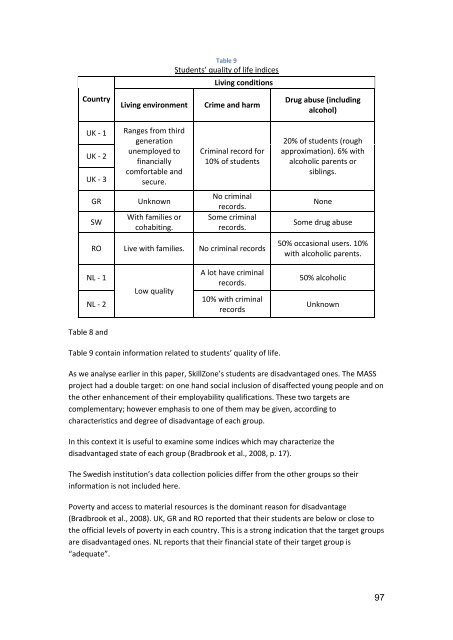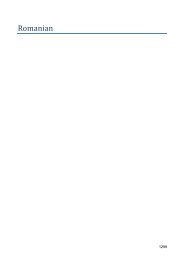Teaching and Assessing Soft Skills - MASS - Measuring and ...
Teaching and Assessing Soft Skills - MASS - Measuring and ...
Teaching and Assessing Soft Skills - MASS - Measuring and ...
You also want an ePaper? Increase the reach of your titles
YUMPU automatically turns print PDFs into web optimized ePapers that Google loves.
Country<br />
UK - 1<br />
UK - 2<br />
UK - 3<br />
Table 9<br />
Students’ quality of life indices<br />
Living conditions<br />
Living environment Crime <strong>and</strong> harm<br />
Ranges from third<br />
generation<br />
unemployed to<br />
financially<br />
comfortable <strong>and</strong><br />
secure.<br />
GR Unknown<br />
SW<br />
With families or<br />
cohabiting.<br />
Criminal record for<br />
10% of students<br />
No criminal<br />
records.<br />
Some criminal<br />
records.<br />
RO Live with families. No criminal records<br />
NL - 1<br />
NL - 2<br />
Table 8 <strong>and</strong><br />
Low quality<br />
A lot have criminal<br />
records.<br />
10% with criminal<br />
records<br />
Table 9 contain information related to students’ quality of life.<br />
Drug abuse (including<br />
alcohol)<br />
20% of students (rough<br />
approximation). 6% with<br />
alcoholic parents or<br />
siblings.<br />
None<br />
Some drug abuse<br />
50% occasional users. 10%<br />
with alcoholic parents.<br />
50% alcoholic<br />
Unknown<br />
As we analyse earlier in this paper, SkillZone’s students are disadvantaged ones. The <strong>MASS</strong><br />
project had a double target: on one h<strong>and</strong> social inclusion of disaffected young people <strong>and</strong> on<br />
the other enhancement of their employability qualifications. These two targets are<br />
complementary; however emphasis to one of them may be given, according to<br />
characteristics <strong>and</strong> degree of disadvantage of each group.<br />
In this context it is useful to examine some indices which may characterize the<br />
disadvantaged state of each group (Bradbrook et al., 2008, p. 17).<br />
The Swedish institution’s data collection policies differ from the other groups so their<br />
information is not included here.<br />
Poverty <strong>and</strong> access to material resources is the dominant reason for disadvantage<br />
(Bradbrook et al., 2008). UK, GR <strong>and</strong> RO reported that their students are below or close to<br />
the official levels of poverty in each country. This is a strong indication that the target groups<br />
are disadvantaged ones. NL reports that their financial state of their target group is<br />
“adequate”.<br />
97





